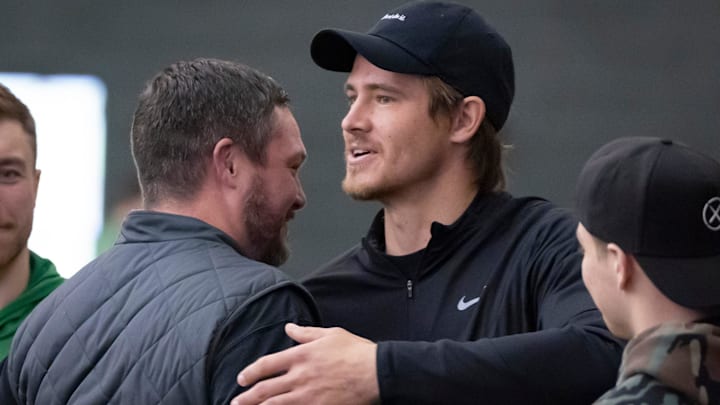Four heads sculpted onto a granite face, oriented to the southeast for maximum sun exposure, the Mount Rushmore National Monument was completed in 1941 by American sculptor Gutzon Borglum and his son Lincoln.
The elder Borglum died at the end of the project. Lincoln oversaw the final stages, though the original vision was for each of the hallowed, consecrated presidents to be depicted from head-to-waist. Funding concerns cut it short: Only Washington's image shows detail below the chin.
G. Borglum chose these four because in his view they represented the four crucial stages in the evolution of the Republic, birth, growth, development and preservation.

In popular culture it's become a symbol and a shorthand for bar and water cooler conversations about legacy and greatness: The hypothetical Mount Rushmore of a given enterprise, the iconic figures worthy of elevation and a monument.
So, who's on the Mount Rushmore of Oregon football, the greatest, the best, the seminal and never-to-be-forgotten?
If we stick strictly to Borglum's vision of birth, development, growth and preservation, the figures might include Len Casanova, Mike Bellotti, Phil Knight and Dan Lanning, with arguments made for Rich Brooks, Chip Kelly, Marcus Mariota and Rob Mullens.
But football belongs to the players. It's no fun to give the projected monument on Spencer's Butte to a pair of grey-haired coaches, a philanthropist and a whippersnapper with a 35-6 record, or any of the other highly-compensated, plush-office types that have passed through.
It's the moments on the field that fuel the passion. That's what endures. There's the greatness, the legacy, the unforgettable strength, speed, poise and grace. Limited to four images only, this is who they have to be:
Mel Renfro
An Oregon Hall of Famer in two sports, and one of six Ducks in the Pro Football Hall of Fame, Renfro was a Consensus All-American and two-time Super Bowl winner who played 14 years in the NFL, all with the Dallas Cowboys.
He led the Ducks in rushing three straight seasons, starred in the defensive backfield and caught 41 passes for 644 yards, 23 total touchdowns.
Shy Huntington, Norm Van Brocklin and George Shaw came before him but Renfro was Oregon's first breath of sustained national excellence in an era the program seldom emerged from the shadows of USC, Washington and UCLA.

Joey Harrington
Captain Comeback did not have the flashy starts of Oregon's up-tempo spread era, but he had 25 wins as a starter and won three bowl games. culminating in a No. 2 national finish in 2001.
He personified the grit and never-die spirit of Oregon's rise to the top level of college football, ushering in the era of Top 25 finishes and national TV exposure. He was one of the first players to throw the "O" and has remained a spokesman and a passionate voice for the program since his retirement from the NFL.
Iconic moments in Autzen: Joey Harrington's Farewell#GoDucks #LeaveALegacy pic.twitter.com/oike9uZLyN
— ☘️LegalizeQuack☘️ (@Legalize_Quack) May 17, 2025
Haloti Ngata
Mike Bellotti called him the best athlete he ever coached, a college football Hall of Famer who demolished offensive lines and destroyed practice in three remarkable seasons as Oregon's first big-time, five-star recruit, the first Duck since Renfro to earn Consensus All-American.
Todays #ThrowbackThursday we bring to you former #Ducks DT Haloti Ngata - @Haloti_Ngata92 is in his 13th year in the NFL and forever an Oregon Duck! #SuperBowlChamp #5TimeProBowl #CaliFLOCK 🦆🔥🦆🔥 pic.twitter.com/Wywqgaj6kA
— OregonGridiron (@OregonGridiron) June 14, 2018
Marcus Mariota
Oregon's only Heisman Trophy winner and the all-time leader in career wins, passing yards and touchdowns, the best tribute to MM8 was delivered by iconic play-by-play man Jerry Allen, who called him not only a Heisman Trophy winner, but a Hall of Fame person.
"Marcus Mariota has kind of made it the top standout season just because of the way he's played and his leadership and the kind of kid he is away from the field." ---Jerry Allen
Mariota has never stopped giving back to the Oregon program, never failed to express gratitude or acknowledge the family and culture that raised him or the teammates and coaches that contributed to his success.
If there were five visages, LaMichael James, Uncle Phil, Kelly, Cota, Shaw, Casanova and the rest all deserve mention. But the iconography dictates four outlines on the mountain. It has to be these four.
On social media fans have brought up names like Kenny Wheaton, Ahmad Rashad and De'Anthony Thomas, but those guys shined in moments. Rushmore is reserved for the titans, the giants who shaped the program in their own image.
